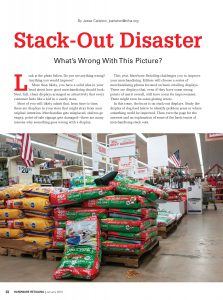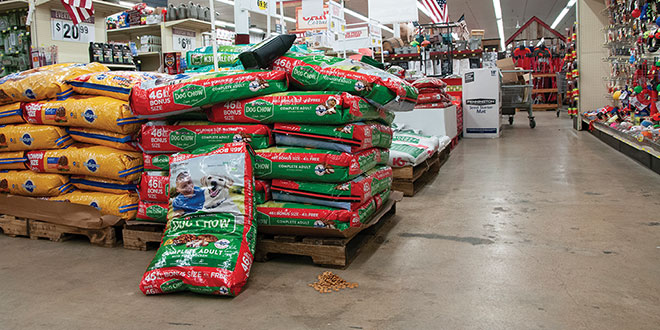
Click the picture to download a PDF of this story.
By Jesse Carleton, jcarleton@nrha.org
Stack-Out Disaster
Look at the photo above. Do you see anything wrong? Anything you would improve?
More than likely, you have a solid idea in your head about how good merchandising should look: Neat, full, clean displays arranged so attractively that every customer feels like a kid in a candy store.
Most of you will likely admit that, from time to time, there are displays in your store that might stray from your original intention. Merchandise gets misplaced, shelves go empty, point-of-sale signage gets damaged—there are many reasons why something goes wrong with a display.
This year, Hardware Retailing challenges you to improve your merchandising. Editors will choose a series of merchandising photos focused on basic retailing displays. These are displays that, even if they have some strong points of merit overall, still have room for improvement. There might even be some glaring errors.
In this issue, the focus is on stack-out displays. Study the display of dog food above to identify problem areas or where something could be improved. Then, look below for the answers and an explanation of some of the basic tenets of merchandising stack outs.

1. Price Check
There are several reasons why stack-out displays are effective. They’re easy to create, they show you are well-stocked in a key product and they promote a low-price image. But they can’t do much to promote that low-price image if the cost is hidden on a small tag. Make the price signage big and bold so it catches every customer’s attention. If you are using the stack-out display to hold items you’ve advertised, consider placing them near other items in the category for add-on sales opportunities.
2. Unwanted Visitor
Since they sit in heavily travelled aisles, stack-out displays might collect strays. Whether it’s an item a customer decided to leave behind or a coffee cup someone set down and forgot, anything that doesn’t belong on the display needs to be discarded as soon as possible. Those items make the display look cluttered and detract from its overall appearance. Keeping merchandising free of debris is important in any area of the store, but especially for displays that sit in a power aisle.
3. Trip Hazard
Always be on the lookout for safety hazards around the salesfloor. A bag sitting on the floor in a busy aisle could get kicked, damaged or even trip customers as they pass. Always restack products as soon as possible. If items are not neatly stacked, straighten them so they are neat and symmetrical. That should be a part of each employee’s regular routine. It only takes a few minutes to straighten up a display as you’re walking past, but it makes a big difference in the store’s overall appearance.
4. Inside Out
When you see damaged product packaging, move it to an area where you can sell it at a discount or discard it. Broken packaging that creates a mess in the aisle makes the store look dirty and leaves a bad impression on shoppers. Spills aren’t always as benign as a broken package of dog food, either. If you have a spill in your paint and chemical aisle, for example, make sure all of your employees are familiar with the proper cleanup procedures and how to vent hazardous fumes.
 Hardware Retailing The Industry's Source for Insights and Information
Hardware Retailing The Industry's Source for Insights and Information








